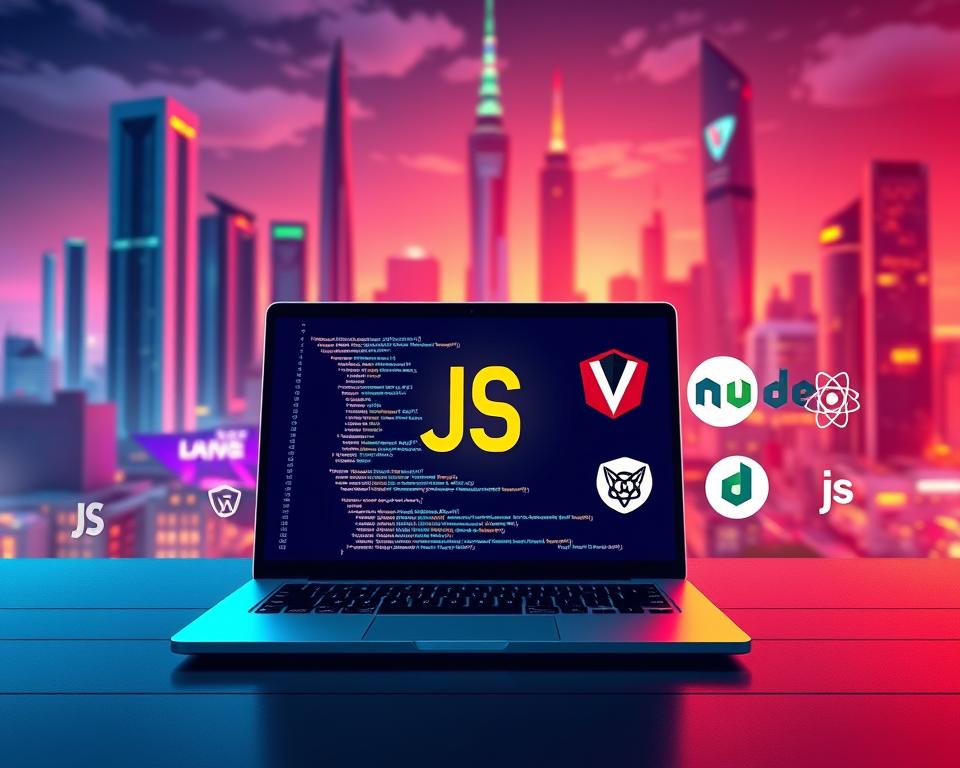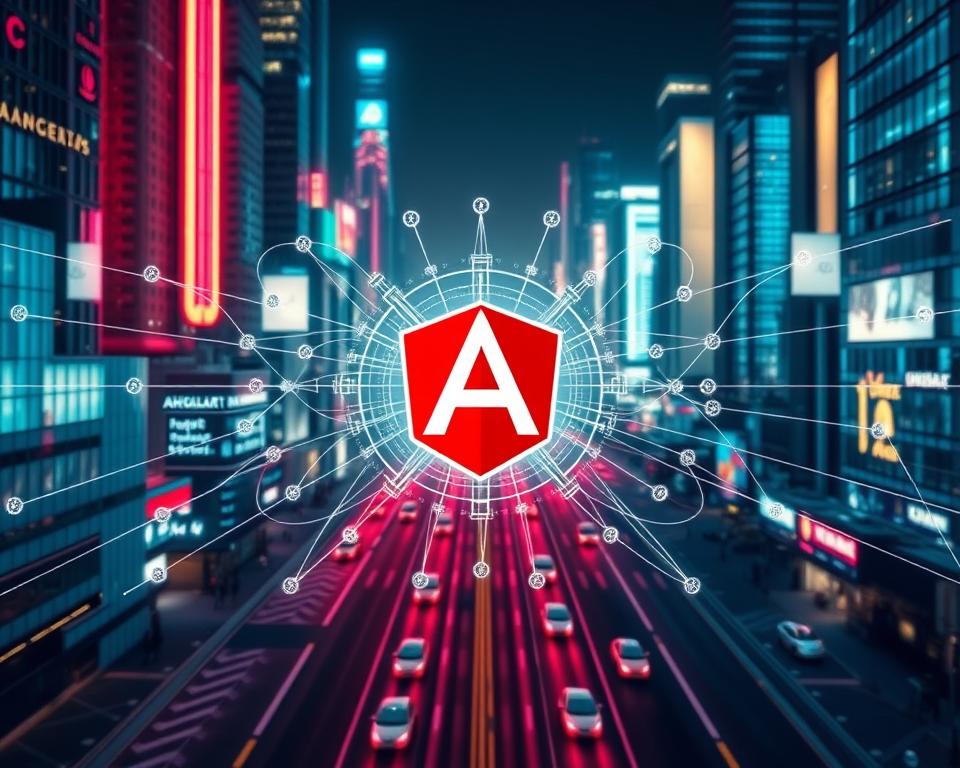JavaScript frameworks are key in web and app development. They help build efficient, scalable, and dynamic apps. These frameworks offer pre-defined components and tools, making app creation easier.
Using a JavaScript framework boosts the development process. It lets developers focus on the app’s core features. This way, they don’t have to start from scratch.
Several top JavaScript frameworks are out there. React, Angular, Vue.js, Next.js, and Express.js are among them. Each has its own strengths and is best for different projects. These frameworks help create high-performance, user-friendly apps that meet today’s user needs.
This article explores JavaScript frameworks in web and app development. We’ll look at their key features, benefits, and use cases. This will help developers pick the best framework for their projects.
Table of Contents
Key Takeaways
- JavaScript frameworks simplify the web development process by providing pre-defined components and tools.
- Top JavaScript frameworks include React, Angular, Vue.js, Next.js, and Express.js.
- Each framework has its unique strengths and use cases, making them suitable for different types of projects.
- JavaScript frameworks can enhance the development experience, allowing developers to focus on core functionality.
- The choice of JavaScript framework depends on the specific needs and goals of the project.
- Understanding the features and benefits of each framework is essential for making an informed decision.
Understanding JavaScript Frameworks in Modern Development
JavaScript frameworks are key in web and app development, making it easier to build complex apps. It’s important to learn about JavaScript framework basics. This includes their history and role in development. The framework evolution has brought many tools and libraries that help developers work better.
The world of development is always changing, with new tech and frameworks popping up all the time. JavaScript frameworks are crucial in this world. They give developers the tools to make apps that are fast, scalable, and easy to keep up. Some main points about JavaScript frameworks are:
- Improved performance and efficiency
- Enhanced user experience
- Simplified development process
As the development world keeps evolving, it’s key to keep up with the latest in JavaScript frameworks. This means knowing the good and bad of using frameworks and the tools and libraries out there. By doing this, developers can make top-notch apps that meet user needs and stay competitive.
In today’s world, frameworks are not just nice to have but are essential. They give developers the base they need to build complex apps fast and well. As the need for quick, scalable, and easy-to-maintain apps grows, so will the role of JavaScript frameworks.
React: The Facebook-Backed Framework Revolution
React, backed by Facebook, has changed how we build user interfaces. It uses a component-based system and a virtual DOM. This makes it easy to create and update UI components.
React boosts app performance by reducing DOM changes. This leads to faster apps and a better user experience. It also helps manage complex apps by breaking them into smaller parts.
React Native is great for making mobile apps. It lets developers build apps for both iOS and Android at the same time. This saves time and money.
- Component-based architecture
- Virtual DOM
- Declarative programming style
- Large community of developers and extensive libraries
React is a top pick for complex user interfaces. Its impact on web and mobile app development is huge. With its strong features and big developer community, React is perfect for high-quality apps.
By using React, developers can create fast, scalable, and maintainable applications, making it an essential tool in the framework revolution.
| Feature | Description |
|---|---|
| Component-based architecture | Allows developers to break down the application into smaller, reusable components |
| Virtual DOM | Improves performance by reducing the number of DOM mutations |
| Declarative programming style | Makes it easier to manage complex applications and predict behavior |
Angular: Google’s Enterprise-Level Development Platform
Angular is a top JavaScript framework made by Google. It’s great for making big, complex apps. It has lots of tools and features for large projects, perfect for companies wanting scalable apps.
Angular’s command-line interface (CLI) makes building apps easier. It also works well with TypeScript. This means your code is strong and easy to keep up with, even for big apps.
Key features of Angular for big projects include:
- Dependency injection
- Services
- Modular architecture
Angular is a strong, flexible framework for big projects. Its tools and TypeScript integration make it great for companies wanting scalable apps.
| Feature | Description |
|---|---|
| Angular CLI | Simplifies the development process and provides a consistent way of building and deploying applications |
| TypeScript Integration | Provides a robust and maintainable codebase, making it easier to develop and debug large-scale applications |
| Dependency Injection | Enables developers to create complex, scalable applications that can be easily maintained and updated |
Vue.js: The Progressive JavaScript Framework
Vue.js is a progressive framework that has become very popular. It’s easy to use and works well for both small and big projects. Its reactive components and simple syntax help developers create and update complex interfaces easily.
Vue.js is known for its progressive nature. This means developers can start small and grow their apps as needed. It’s perfect for any size project. Plus, Vue.js has a big community and tools like Vue CLI and Vue Router, making app building and deployment simple.
Using Vue.js has many benefits:
- It’s easy to learn and use.
- It’s highly customizable.
- It has a strong ecosystem of tools and libraries.
In summary, Vue.js is a strong and adaptable progressive framework for complex web apps. Its simplicity, flexibility, and robust ecosystem make it a favorite among developers.
Next.js: The React Framework for Production
Next.js is a well-liked React framework for making production-ready apps. It has many features for server-side rendering, static site generation, and improving performance.
Developers can make fast, scalable, and secure apps with Next.js. It helps with SEO and makes pages load quickly. Static site generation lets you create websites that can be hosted anywhere.
Server-Side Rendering Capabilities
Next.js supports server-side rendering. This means React components are rendered on the server. It boosts SEO and makes pages load faster.
Static Site Generation
Next.js also supports static site generation. This lets you make static websites that can be hosted on any server. It’s great for sites that don’t need dynamic data or user interaction.
Performance Optimization Features
Next.js has many features to improve performance. It includes code splitting, tree shaking, and minification. These help make the app bundle smaller, leading to faster page loads and a better user experience.
Using Next.js, developers can build fast, scalable, and secure apps. Its wide range of features and performance optimization make it perfect for complex web applications.
| Feature | Description |
|---|---|
| Server-Side Rendering | Improves SEO and provides faster page loads |
| Static Site Generation | Enables the creation of static websites that can be hosted on any server |
| Performance Optimization | Reduces the size of the application bundle, resulting in faster page loads |
Express.js: Backend Development Simplified
Express.js is a well-liked Node.js framework for making backend apps. It’s known for being simple and using a middleware-based setup. This makes it great for quick development and flexible routes. Developers can easily make RESTful APIs and real-time web apps with it.
Using Express.js makes backend development easier. It has many features like HTTP method support, URL routing, and middleware functions. This lets developers concentrate on writing app logic, not the infrastructure. For instance, it can help build a real-time web application that updates instantly, without needing a full page reload.
Some of the key features of Express.js include:
- Support for HTTP methods, including GET, POST, PUT, and DELETE
- URL routing, allowing developers to map URLs to specific application logic
- Middlewares, which can be used to perform tasks such as authentication and logging
Overall, Express.js is a strong tool for backend development. It offers a flexible and scalable framework for web apps. By using Node.js and Express.js, developers can make fast, efficient, and scalable apps for modern web needs.
Evaluating Top JavaScript Frameworks for Web & App Development
When picking a JavaScript framework, several things matter. Performance metrics like speed and memory use are key. The learning curve also plays a big role. A framework that’s easy to learn can speed up development, while a hard one can slow it down.
Looking at performance metrics is important. This means checking how fast the framework is, how much memory it uses, and how well it scales. For example, React is fast and uses memory well, making it great for big apps. Angular, on the other hand, is more complex but offers strong features for big projects.
Another important thing is community support. A framework with a strong community offers lots of help. This includes guides, tutorials, and forums. This makes learning easier and helps solve common problems. As NextBigTechnology points out, a good community is key to a framework’s success.
Some important things to think about when choosing a framework are:
- Performance metrics: speed, memory usage, scalability
- Learning curve: how easy it is to start, and the availability of guides and tutorials
- Community support: how active the community is, and the resources available
By considering these factors, developers can pick the best JavaScript framework for their projects.
Emerging JavaScript Frameworks to Watch
The world of JavaScript is always changing. New frameworks keep popping up to meet the needs of developers. Svelte and Solid.js are two emerging frameworks that are making waves with their fresh approaches to web app building.
Svelte is special because it compiles code before it reaches the browser. This means the browser has less to do, making apps run faster and smoother. It’s a big win for developers aiming for top-notch performance.
Key Features of Svelte and Solid.js
- Svelte: compiler-based, improved performance, smaller bundle sizes
- Solid.js: performance-oriented, small footprint, easy to learn
Solid.js, meanwhile, is all about building fast apps with a small footprint. Its API is simple and straightforward. This makes it a breeze for developers to start and build apps that scale well.
As emerging frameworks like Svelte and Solid.js grow in popularity, they’re set to shape the future of JavaScript. They focus on performance, simplicity, and ease of use. These frameworks are definitely worth keeping an eye on in the years to come.
| Framework | Key Features | Use Cases |
|---|---|---|
| Svelte | Compiler-based, improved performance, smaller bundle sizes | High-performance web applications, progressive web apps |
| Solid.js | ||
| Performance-oriented, small footprint, easy to learn | High-performance web applications, real-time web applications |
Framework Selection Criteria for Different Project Types
Choosing the right framework for web development is key. It depends on the project types. The right framework can greatly impact the project’s success.
For small web apps, a simple framework is best. But, big enterprise apps need something strong. Real-time apps require fast data processing.
When picking a framework, think about performance, team size, and needed features. The right choice ensures a smooth development process.
Finding the perfect framework is all about matching it with the project’s needs. This way, developers can build top-notch web apps.
Common Implementation Challenges and Solutions
Developers often face challenges when using JavaScript frameworks. These issues can affect how well an app works, how fast it loads, and how well it scales. One big problem is performance optimization. Slow apps can make users unhappy.
To solve these implementation challenges, developers use several methods. They split code, make it smaller, and use caching. They also use content delivery networks (CDNs) to speed things up.
Performance Optimization Strategies
- Code splitting and lazy loading
- Minification and compression
- Caching mechanisms and CDNs
Another key area is security. Apps need to be safe from threats. Developers must use strong login systems, check user input, and update their code regularly.
Security Considerations
By tackling these common problems, developers can make apps that are fast, safe, and easy to use. Focusing on performance optimization and security is crucial. This way, their JavaScript apps will be reliable and successful.
Framework Integration Best Practices
When integrating frameworks, a solid architecture is key. It ensures smooth work with other tools and technologies. This includes backend services, databases, and third-party libraries. By sticking to best practices, developers can make their apps strong, easy to update, and grow with demand.
To get framework integration right, keep these tips in mind:
- Define a clear architecture and design pattern
- Choose the right tools and technologies for the project
- Implement a modular and flexible code structure
- Use established best practices for coding and testing
By following these best practices for framework integration, developers can build apps that are efficient, scalable, and easy to keep up. These apps will meet their users’ needs well.
Successful framework integration requires a deep understanding of the underlying technologies and a well-planned architecture.
| Best Practice | Description |
|---|---|
| Modular code structure | Break down the code into smaller, independent modules for easier maintenance and scalability |
| Established coding standards | Follow established coding standards and guidelines to ensure consistency and readability |
| Thorough testing | Perform thorough testing to ensure the application is robust and functions as expected |
Future Trends in JavaScript Framework Development
The web development world is always changing. New future trends are emerging. One big trend is using Web Assembly with JavaScript. It makes websites load faster and work better.
Another trend is the rise of micro-frontend architecture. It breaks down big apps into smaller parts. Each part does its own thing. This makes apps easier to grow and maintain.
- Improved scalability and flexibility
- Easier maintenance and updates
- Enhanced collaboration and integration
AI and machine learning are also big for web development’s future. They help make apps smarter and more user-friendly. Keeping up with future trends like Web Assembly and micro-frontend is key to making great apps.
Conclusion
Looking ahead, JavaScript frameworks will keep shaping web development. They are key with serverless computing, TypeScript, and WebAssembly. Developers can now build fast, scalable apps. For more on these trends, check out JavaScript frameworks for web development.
JavaScript frameworks make app development easier. Knowing each framework’s strengths and weaknesses helps developers choose the right tools. Staying current with new developments ensures they use the best tools for quality apps.



















